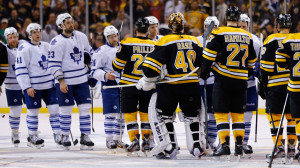Part 2: Focus on the playoffs

Part 1: A look at the numbers Part 2: Focus on the playoffs
Part 3: Forwards
Part 4: Defence + Goalie
Part 5: Free-Agency Situations: Who will stay or who will go?
Part 6: Draft
Part 7: The Leafs’ new division

credit: Jared Wickerham/Getty Images
Many Toronto Maple Leafs fans felt their heart break when the Boston Bruins eliminated them in overtime of Game 7. But what many Leafs fans were not expecting was for the Maple Leafs to be the toughest opposition Boston would face on the way to the Stanley Cup Finals.
Toronto came within minutes of ending Boston’s season, but the New York Rangers lasted even fewer games before being eliminated in Game 5. The Pittsburgh Penguins fared even worse against the Bruins, being swept in the Eastern Conference Final.
Even more surprising than the Penguins getting swept, both Sidney Crosby and Evgeni Malkin were held pointless. Phil Kessel, Cody Franson and Joffrey Lupul all scored more goals against Boston than the entire Penguins team put together.
The Bruins have proven themselves to be a very strong team defensively, and as a team appeared to have the Maple Leafs’ number. This success in addition to the Kessel trade gave the media lots of opportunities to craft a narrative regarding Kessel’s inability to succeed against his old team, but also of the Leafs in general versus the Bruins. Game 1 seemed to confirm many suspicions, but nothing is ever so easy.
I will not be going over each game in detail, as there are recaps for each game in the series, but I will mention some general trends and lessons about the Leafs playoffs this year and what it can mean.
The first thing I want to point out is the age of the team. The Toronto Maple Leafs were the youngest team in the NHL and in a way proved it by not being able to finish off the Bruins in game seven. The Leafs however are young enough to absorb this lesson and let it motivate them for next year. The addition of a veteran or two could give the Leafs the boost they need to make it past the first round.
The next point I want to make has to do with Kessel. He is, perhaps unfairly, targeted by the media when the Leafs lose. Kessel started the season with a 10-game goalless drought, but he did put up points through assists. Kessel has expanded his game, becoming an excellent passer, as well as improving his back-checking. Kessel’s speed can get him places that few could match.
Kessel has also had difficulties succeeding against the Bruins, often having to try to score on Zdeno Chara. Randy Carlyle, with his propensity for matching, was able to find time for Kessel to play while Chara was on the bench. The Leafs also spread out their offensive power, putting Lupul on with Nazem Kadri on the third line. This meant that the Leafs could get at least one good offensive pairing on the ice when they needed to.
As far as the defensive side of the ice, Franson and Jake Gardiner both proved they have a future in the blue and white. Franson played well on the power play, manning the point. Gardiner showed his puck-moving skills and offensive creativity. However, one bit of concern is that Gardiner did not slot into the line-up until Mike Kostka was injured with a broken finger.
For the most part Carlyle’s system seemed to work, but one aspect that stood out to me, was the way in which the team which switch into a total defensive mode once they gained a lead in the third period. This seems easy to point out now, but Carlyle appeared to make tiny judgement errors which accumulate into a Game 7 defeat.
The Maple Leafs played better than many predicted but still broke the hearts of many fans with the way they lost a 4-1 lead, but that happens sometimes in hockey. The Leafs have lessons to learn, but also some small victories to celebrate. The Leafs will not be able to just rest on their laurels, but must be better next year to meet the fans’ growing expectations.
For part 3 of the recap, I will take a closer look at the Toronto forwards and how their forward corps has shaped out.


